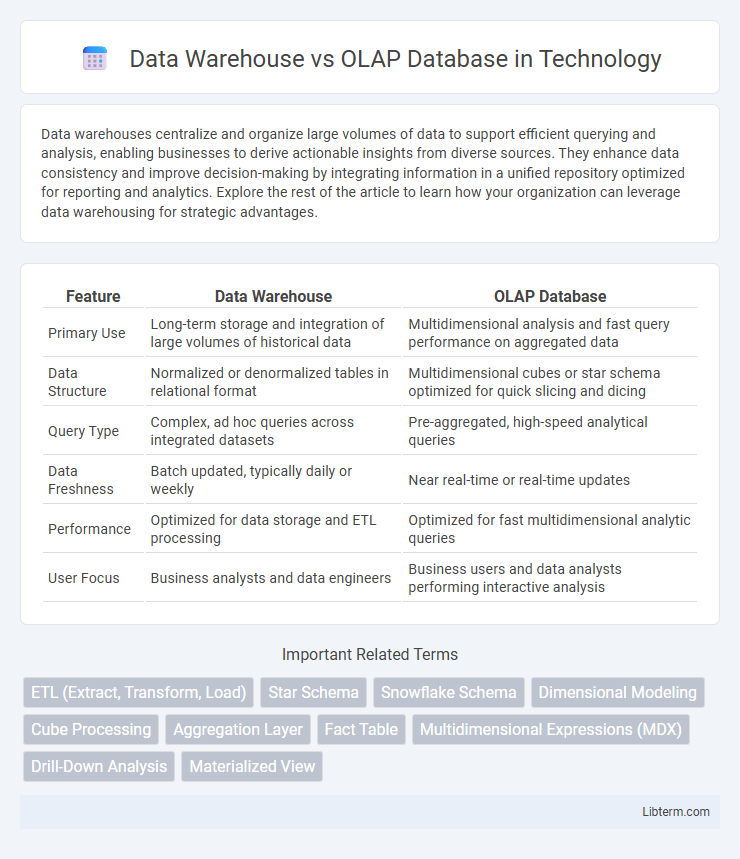Data warehouses centralize and organize large volumes of data to support efficient querying and analysis, enabling businesses to derive actionable insights from diverse sources. They enhance data consistency and improve decision-making by integrating information in a unified repository optimized for reporting and analytics. Explore the rest of the article to learn how your organization can leverage data warehousing for strategic advantages.
Table of Comparison
| Feature | Data Warehouse | OLAP Database |
|---|---|---|
| Primary Use | Long-term storage and integration of large volumes of historical data | Multidimensional analysis and fast query performance on aggregated data |
| Data Structure | Normalized or denormalized tables in relational format | Multidimensional cubes or star schema optimized for quick slicing and dicing |
| Query Type | Complex, ad hoc queries across integrated datasets | Pre-aggregated, high-speed analytical queries |
| Data Freshness | Batch updated, typically daily or weekly | Near real-time or real-time updates |
| Performance | Optimized for data storage and ETL processing | Optimized for fast multidimensional analytic queries |
| User Focus | Business analysts and data engineers | Business users and data analysts performing interactive analysis |
Introduction to Data Warehousing and OLAP
Data warehousing involves collecting and managing large volumes of historical data from multiple sources, enabling comprehensive analysis and reporting. OLAP (Online Analytical Processing) databases are specialized systems within data warehousing designed for fast querying and multidimensional analysis of data, supporting complex calculations and trend identification. While data warehouses store integrated datasets, OLAP databases optimize this data for analytical tasks, improving decision-making efficiency.
What is a Data Warehouse?
A Data Warehouse is a centralized repository that stores large volumes of structured and processed data from multiple sources, designed to support business intelligence and analytical reporting. It integrates data across various systems, enabling complex queries and historical analysis with optimized read performance. Unlike OLAP databases, which focus on multidimensional data analysis, data warehouses provide a foundational platform for data consolidation and consistent decision-making.
What is an OLAP Database?
An OLAP database is a specialized type of data storage optimized for online analytical processing, enabling complex queries and multidimensional analysis of large volumes of data. Unlike traditional data warehouses that focus on storing vast amounts of raw data, OLAP databases structure data into cubes for rapid aggregation and slicing, supporting decision-making and business intelligence tasks. These databases allow users to perform trend analysis, forecasting, and data modeling efficiently across multiple dimensions such as time, geography, and product lines.
Core Differences Between Data Warehouse and OLAP
Data Warehouses are large-scale repositories designed for integrating and storing vast amounts of historical transactional data from multiple sources, supporting comprehensive business intelligence and reporting. OLAP databases specialize in multidimensional data analysis, enabling fast query performance and complex calculations through pre-aggregated, summarized datasets. The core difference lies in Data Warehouses serving as centralized data storage platforms, while OLAP databases provide optimized, real-time analytical processing for decision support.
Data Storage Architecture Comparison
Data warehouses use a centralized storage architecture designed to integrate and store large volumes of structured data from multiple sources, optimized for complex query processing and historical analysis. OLAP databases utilize multidimensional storage models, such as star or snowflake schemas, to enable fast aggregation and slicing of data across different dimensions for real-time analytical querying. The data warehouse emphasizes ETL processes and batch updates, while OLAP focuses on pre-aggregated data cubes to accelerate analytical performance.
Query Performance: Data Warehouse vs OLAP
Data warehouses are designed for storing large volumes of historical data, enabling comprehensive query analysis but often resulting in slower performance for complex queries due to data size and structure. OLAP databases utilize multidimensional data models and aggregated data cubes, which optimize query performance by allowing rapid slicing, dicing, and drill-down operations. Query response times in OLAP systems are typically faster than in traditional data warehouses, making them ideal for interactive data analysis and decision support.
Use Cases for Data Warehouse Solutions
Data warehouse solutions support large-scale data integration, enabling complex analytics across diverse sources for strategic decision-making in industries like retail, finance, and healthcare. They handle historical data storage and facilitate trend analysis, forecasting, and business intelligence reporting that optimize operations and customer insights. Use cases often include executive dashboards, sales performance monitoring, and regulatory compliance tracking where unified data views are essential.
Use Cases for OLAP Databases
OLAP databases excel in complex analytical queries, enabling multidimensional data analysis for business intelligence, financial forecasting, and sales trend identification. They support rapid aggregation, slicing, and dicing of large volumes of data, making them ideal for real-time decision-making and performance analysis. Use cases include executive dashboards, market segmentation analysis, and predictive analytics in retail and telecommunications sectors.
Choosing the Right Solution: Data Warehouse or OLAP
Choosing between a Data Warehouse and an OLAP database depends on specific analytical needs and data complexity. Data Warehouses optimize large-scale, historical data integration and support extensive querying with batch processing, while OLAP databases enable fast, multi-dimensional analysis and real-time data exploration for business intelligence. Evaluating factors like query speed, data granularity, and use case scenarios ensures selecting the most effective data architecture for accurate decision-making.
Future Trends in Data Warehousing and OLAP Technologies
Future trends in data warehousing emphasize cloud-native architectures, leveraging scalable and flexible storage solutions to handle exponential data growth. OLAP technologies increasingly integrate artificial intelligence and machine learning for advanced analytics, enabling real-time decision-making and predictive insights. The convergence of data warehousing with big data platforms and multicloud environments fosters seamless data integration and enhanced performance in analytical processing.
Data Warehouse Infographic

 libterm.com
libterm.com